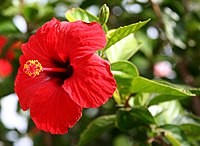
Photo from wikipedia
Hibiscus (Hibiscus rosa-sinensis L.) is a tropical perennial shrub frequently cultivated as an ornamental plant in southwest Iran. Virus-like symptoms including leaf mosaic, mottling and malformation have been observed on… Click to show full abstract
Hibiscus (Hibiscus rosa-sinensis L.) is a tropical perennial shrub frequently cultivated as an ornamental plant in southwest Iran. Virus-like symptoms including leaf mosaic, mottling and malformation have been observed on hibiscus plants during 2015–2017. Infectivity of the causal agent of the symptoms was proved through mechanical transmission to indicator plants. The cotton-melon aphid (Aphis gossypii G.) was shown to transmit the causal agent with a very low efficiency. A tobamoviral infection was detected in symptomatic leaves by ELISA. Tomato mosaic virus (ToMV) coat protein (CP) gene was amplified in infected samples and sequenced completely. Nucleotide comparison of the sequences showed 96–98% identity to Iranian isolates of ToMV. Phylogenetic analysis of nucleotide and amino acid sequence of ToMV isolates originating from various sources and diverse geographical locations was performed and ToMV isolates were classified into two clades, Clade I and Clade II. ToMV isolates obtained in this study were placed in Clade II and formed a separate subclade. Multiple alignment of amino acid sequences demonstrated several substitutions in CPs of hibiscus-infecting ToMV isolates which might contribute to the variations in symptoms induced by them. The results showed the first record of ToMV infecting an ornamental plant in Iran.
Journal Title: Journal of Plant Pathology
Year Published: 2020
Link to full text (if available)
Share on Social Media: Sign Up to like & get
recommendations!